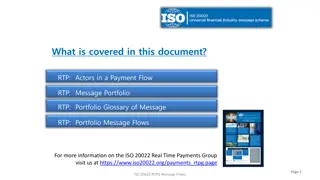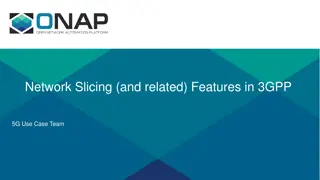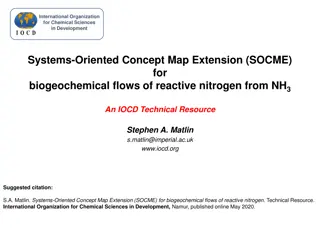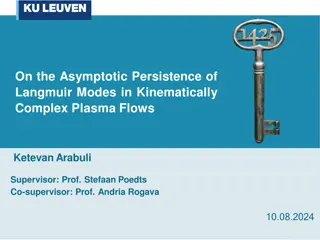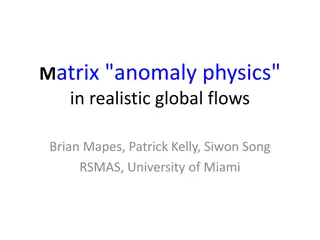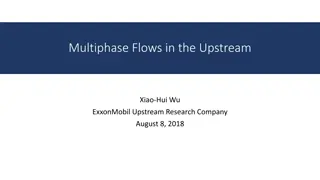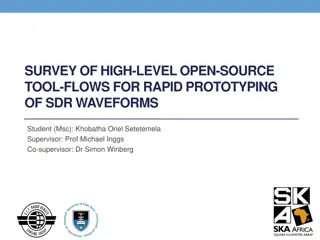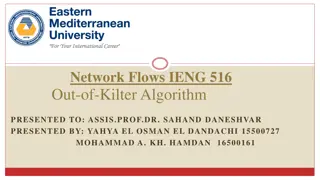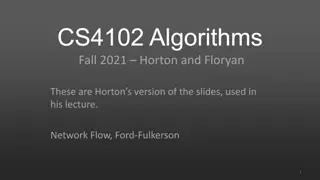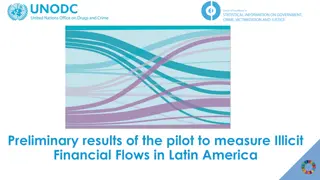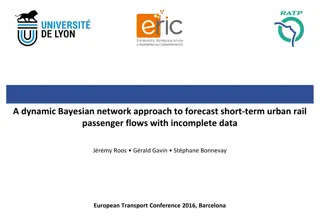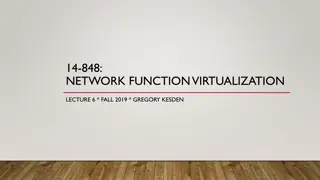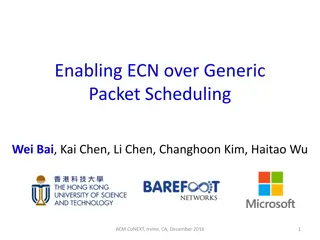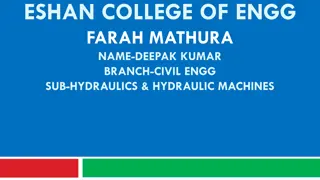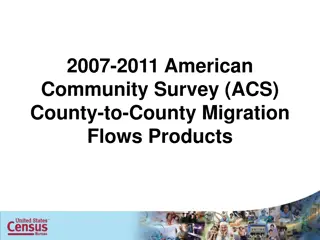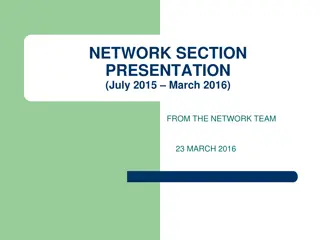Apache MINA: High-performance Network Applications Framework
Apache MINA is a robust framework for building high-performance network applications. With features like non-blocking I/O, event-driven architecture, and enhanced scalability, MINA provides a reliable platform for developing multipurpose infrastructure and networked applications. Its strengths lie i
3 views • 13 slides
Modeling and Generation of Realistic Network Activity Using Non-Negative Matrix Factorization
The GHOST project focuses on the challenges of modeling, analyzing, and generating patterns of network activity. By utilizing Non-Negative Matrix Factorization (NMF), realistic network activity patterns can be created and injected into live wireless networks. Understanding and predicting user behavi
4 views • 28 slides
Automated Anomaly Detection Tool for Network Performance Optimization
Anomaly Detection Tool (ADT) aims to automate the detection of network degradation in a mobile communications network, reducing the time and effort required significantly. By utilizing statistical and machine learning models, ADT can generate anomaly reports efficiently across a large circle network
8 views • 7 slides
Challenges in Multinational Capital Budgeting
Multinational Capital Budgeting extends the domestic analysis to evaluate foreign projects, focusing on cash flows, risk adjustments, and real option analysis. It involves complexities such as distinguishing parent cash flows from project cash flows, dealing with differing tax systems, political con
3 views • 15 slides
Revolutionizing Network Management with Intent-Based Networking
Explore the concept and benefits of Intent-Based Networking (IBN) in simplifying network configuration and enhancing efficiency. Learn how IBN automates network operations, aligns with business objectives, improves security, and ensures scalability and reliability. Discover the potential of IBN tool
0 views • 14 slides
Understanding Max Flow in Network Theory
In network theory, understanding the concept of maximum flow is crucial. From finding paths to pushing flow along edges, every step contributes to maximizing the flow from a source to a target in the graph. The process involves determining capacities, creating flows, and calculating the net flow ent
2 views • 41 slides
Real-Time Payments: Actors and Message Flows Overview
This document provides an overview of the actors involved in a payment flow and the message portfolio in Real-Time Payments (RTP). It includes details on various actors like Instructing agent, Forwarding agent, Ultimate Debtor, Reimbursement agents, and more. The provided message flows illustrate th
1 views • 12 slides
Network Compression Techniques: Overview and Practical Issues
Various network compression techniques such as network pruning, knowledge distillation, and parameter quantization are discussed in this content. The importance of pruning redundant weights and neurons in over-parameterized networks is highlighted. Practical issues like weight pruning and neuron pru
0 views • 37 slides
Network Slicing with OAI 5G CN Workshop Overview
Overview of Network Slicing with OAI 5G CN workshop focusing on the crucial role of network slicing in realizing the service-oriented 5G vision. This workshop covers topics like multiple logical networks creation on shared infrastructure, different types of network slices, preparation and instantiat
1 views • 6 slides
Network Design Challenges and Solutions in Business Data Communications
Issues in designing a Local Area Network (LAN) include needs analysis, technological design, and cost assessment. The traditional approach involves structured systems analysis, but faces challenges due to rapidly changing technology and increasing network traffic. The Building Blocks Approach recomm
1 views • 20 slides
Understanding Capital Budgeting Process and Estimating Cash Flows
The capital budgeting process involves identifying and selecting investment projects with returns extending beyond a year. It includes generating proposals, estimating after-tax incremental cash flows, and selecting projects based on value-maximizing criteria. Investment project proposals are classi
0 views • 31 slides
Overview of Network Slicing and Features in 3GPP 5G Use Case Team
Network slicing in 3GPP's 5G architecture allows for the creation of logical networks with specific capabilities. The end-to-end slicing process involves various network functions like Access and Mobility Management Function (AMF), Session Management Function (SMF), and User Plane Function (UPF). S-
0 views • 12 slides
Understanding 5G RAN Network Slicing and Architecture
Explore the intricate world of 5G Radio Access Network (RAN) and Network Slicing, delving into concepts such as SO Service Orchestrator, SDN-C Service Design, and Core Network Elements. Discover the significance of managing and designing mobile slice services, including eMBB, Massive IoT, and Missio
0 views • 26 slides
Understanding Snort: An Open-Source Network Intrusion Detection System
Snort is an open-source Network Intrusion Detection System (NIDS) developed by Cisco, capable of analyzing network packets to identify suspicious activities. It can function as a packet sniffer, packet logger, or a full-fledged intrusion prevention system. By monitoring and matching network activity
0 views • 23 slides
Data Flows and Network Challenges in Particle Physics Infrastructure
This overview delves into the data flows and network challenges faced in particle physics infrastructure, focusing on the JUNO project. It discusses the process of data reception, storage, and replication across various data centers, highlighting the bidirectional nature of data flows. Additionally,
0 views • 24 slides
Transportation Network Modeling and Analysis with C.Coupled SE Platform
This content outlines the features and functionalities of the C.Coupled SE Platform (CSET Platform) developed by the Connetics Transportation Group. It covers aspects such as interface design, inputs merging, purposes, platform development using Cube, TAZs merging, and network attributes. The platfo
0 views • 11 slides
Systems-Oriented Concept Map Extension for Reactive Nitrogen Flows
International Organization for Chemical Sciences in Development presents a Systems-Oriented Concept Map Extension (SOCME) focusing on biogeochemical flows of reactive nitrogen from NH3. The concept explores core reaction subsystems, energy input subsystems, equilibrium conditions, and the integratio
0 views • 11 slides
Meridian: An SDN Platform for Cloud Network Services
Meridian is an SDN platform developed by Mohammad Banikazemi, David Olshefski, Anees Shaikh, John Tracey, and GuohuiWang at IBM T. J. Watson Research Center. The platform focuses on providing cloud network services efficiently. It encompasses an architecture that enables faster and more convenient n
0 views • 21 slides
Understanding Volcanic Hazards: Tephra, Ash Clouds, and Lava Flows
Explosive volcanic eruptions produce tephra, fragments of rock that can be carried by volcanic plumes, ash clouds, and lava flows. Tephra, including blocks, bombs, and lapilli, poses aviation hazards, infrastructure disruptions, and health risks. Ashfall can impact communities and agriculture over v
0 views • 4 slides
Persistence of Langmuir Modes in Complex Shear Flows
Exploring the persistence of Langmuir modes in kinematically complex plasma flows with a focus on shear flows in nature and historical backgrounds. The research delves into the methodology of classical theory and introduces the nonmodal approach to address limitations. Details on shear flow definiti
0 views • 16 slides
Exploring Anomalies in Realistic Global Flows Using Matrix Physics
Investigate how matrix physics can provide a novel approach in understanding global climate models, focusing on realistic global flows and anomalies. The study aims to move beyond traditional algorithmic rule sets, examining how deviations from time mean flows can affect climate and weather patterns
0 views • 35 slides
Multiphase Flows in the Upstream: A Comprehensive Overview
This content delves into the complexities of multiphase flows in the upstream sector, covering topics such as reservoir management, drilling, subsurface imaging, and reservoir modeling. It explores the challenges of multi-scale phenomena, multi-physics interactions, uncertainty, and inversion in the
0 views • 4 slides
Survey of High-Level Open-Source Tool-Flows for Rapid Prototyping of SDR Waveforms
This research project explores the use of high-level open-source tool-flows for rapidly prototyping software-defined radio (SDR) waveforms. It delves into the motivation, design productivity gap, basics of SDR, ideal requirements for high-level SDR tool-flows, and a survey of potential tools. The st
0 views • 17 slides
Understanding the Out-of-Kilter Algorithm for Network Flows in IENG 516
Delve into the Out-of-Kilter Algorithm, a primal-dual approach for optimizing network flows by balancing kilter states of edges and node variables. Learn about the formulation, tracking variables, algorithm explanation, kilter number rules, and initiating the process.
0 views • 26 slides
Understanding UML Activity Diagrams in Software Design
UML Activity Diagrams provide a modern way to visualize business processes, workflows, data flows, and complex algorithms in software systems. They use symbols to represent different parties involved, actions performed, transitions, and control flows. These diagrams help in modeling data flows, obje
0 views • 14 slides
Understanding Network Analysis: Whole Networks vs. Ego Networks
Explore the differences between Whole Networks and Ego Networks in social network analysis. Whole Networks provide comprehensive information about all nodes and links, enabling the computation of network-level statistics. On the other hand, Ego Networks focus on a sample of nodes, limiting the abili
0 views • 31 slides
Understanding Network Flows and Applications
Explore the concepts of network flows, including Ford-Fulkerson, maximum flow calculations, and handling complications like antiparallel edges. Learn about flow networks in various applications such as transportation and computer networks. Discover methods for adjusting flow graphs and assigning val
0 views • 40 slides
The Impact of Global Financial Cycle on Capital Flows
Global Financial Cycle (GFCy) has been a topic of interest among researchers, with studies analyzing its effects on capital flows. While some argue for its significance, others find little evidence of substantial influence. Understanding GFCy is crucial for policymakers to navigate synchronized econ
0 views • 55 slides
Preliminary Results of Pilot Study on Illicit Financial Flows in Latin America
This pilot study aims to measure illicit financial flows in Latin America, focusing on various illicit markets such as drugs, human trafficking, smuggling of migrants, and illegal mining. The study involves adapting a conceptual framework and testing a methodology to measure these flows across parti
0 views • 15 slides
Understanding Aerodynamics Fundamentals and Principles
Delve into the world of aerodynamics with an exploration of fundamental principles, equations, flow types, Mach number regimes, and vector relations. Discover the distinctions between inviscid and viscous flows, incompressible and compressible flows, as well as the various Mach number regimes from s
0 views • 17 slides
Unveiling Illicit Financial Flows: Who, What, Why, Where, and When
Explore the depths of illicit financial flows as Joseph Stead delves into the origins, impact, and key players involved in this global issue. From the illegal acquisition of funds to their transfer and spending, uncover the detrimental effects on development, lost tax revenue, and perpetuation of co
0 views • 9 slides
Forecasting Short-Term Urban Rail Passenger Flows Using Dynamic Bayesian Networks
A study presented a dynamic Bayesian network approach to forecast short-term urban rail passenger flows in the Paris region. The research addresses the challenges of incomplete data, unexpected events, and the need for real-time forecasting in public transport networks. By leveraging Bayesian networ
0 views • 19 slides
Network Function Virtualization (NFV) Overview
Network Function Virtualization (NFV) focuses on virtualizing network functions to improve efficiency and reduce costs in network infrastructure. The lecture discusses key readings, devices that compose a network, specialization of devices, benefits of one-device-does-anything approach, and the goal
0 views • 21 slides
Enhancing Network Stability with Network Monitoring Systems
Network monitoring is crucial for efficient management and proactive issue detection in a network environment. Factors influencing an effective network system include choosing the best OEM, SLA agreements, and selecting a reliable System Integrator. Reactive monitoring can lead to financial losses a
0 views • 12 slides
Enhancing Data Center Network Performance through Packet Scheduling and ECN
Explore the advancements in data center network performance improvement through techniques like packet scheduling, Explicit Congestion Notification (ECN), and strict priority for different types of flows. The research discusses the requirements of low latency for short messages and high throughput f
0 views • 48 slides
Understanding Open Channel Hydraulics: Types of Channels, Flows, and More
Gain insights into open channel hydraulics covering topics like types of channels, various flows, velocity distribution, discharge mechanisms, and economical channel sections. Delve deeper into specific energy, hydraulic jump, gradually varied flow, and the distinction between steady/unsteady and un
0 views • 11 slides
Analysis of County-to-County Migration Patterns in the United States
The U.S. Census Bureau has released new data and tools allowing users to explore migration patterns across counties. The products include County-to-County Migration Flows Package with Excel tables and Census Flows Mapper for analyzing migration patterns at national and regional scales. Detailed tabl
0 views • 32 slides
Two-Dimensional Mathematical Model of Flows in Thin Film Composite Membranes
This study presents a mathematical model for flows in thin film composite membranes, focusing on the permeation of solvent flux and solute rejection. Assumptions include incompressible fluid, constant diffusion of chemical species, and isothermal conditions. Equations describe water flux, solute flu
0 views • 19 slides
Accelerating Systemic Change Network Inaugural Workshop Summary
The Accelerating Systemic Change Network held its inaugural workshop at Howard Hughes Medical Institute in July 2016 to address the lack of coordination in improving higher education. With a vision to become a professional hub for change researchers in STEM education, the network aims to enhance ind
0 views • 5 slides
University Network Section Overview July 2015 - March 2016
The presentation covers the network team structure, team members, objectives, goals, report outline, network statistics, accomplishments, and future plans of the university network section from July 2015 to March 2016. It highlights efforts to provide stable internet and intranet services, restructu
0 views • 16 slides






